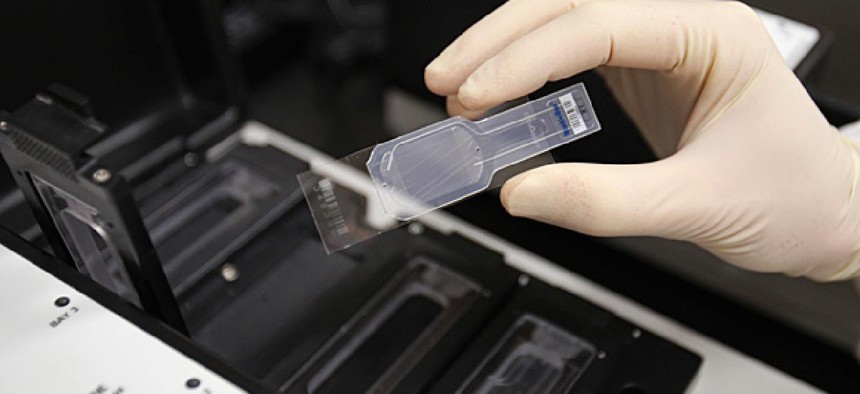DHS defends acquisition plan for bioweapon detectors

A slide prepared for testing for biological hazards. Ben Margot/AP
Several auditors and lawmakers have urged the department to pause reassess its effort
WASHINGTON -- The Obama administration on Thursday defended plans to press ahead in vetting and acquiring a new generation of sensors designed to provide early warning of a biological weapons attack, even as auditors and some lawmakers urged it to pause and reassess the effort.
Before finalizing a blueprint three years ago for procuring a third generation of Biowatch detectors, the Homeland Security Department carried out a faulty evaluation that failed to ask if the new equipment was necessary or would prove effective once deployed, the congressional Government Accountability Office said in a report issued this week. The developmental technology is designed to autonomously gather and evaluate air samples for the presence of dangerous organisms such as anthrax between four and six times each day; Biowatch gear now in 30 U.S. cities requires the physical removal of filters on a routine basis for assessment in local laboratories.
The department accepted GAO recommendations to re-examine the necessity for the effort and possible alternatives, as well as to "develop performance, schedule, and cost information in accordance with guidance and good acquisition practices." However, it rejected advice from auditors to delay procurement efforts until completing the administrative steps.
"All of those things take time, and during that time period, we do not want to delay ... the technology side of the coin," Assistant Homeland Security Secretary Alexander Garza said at a joint hearing convened on Thursday by two House Homeland Security subcommittees
Department officials last month approved plans to move forward with "an analysis of alternatives" that would incorporate "testing of a small number of detector units from each competitively selected vendor," Garza said in written testimony.
"There is not going to be any performance testing during that time period," he told lawmakers during a question-and-answer session. "When you come to the end of the day, we are going to be aligned with exactly what GAO is saying, to complete these documents before we start performance testing."
Some lawmakers, though, voiced concern over the planning by Homeland Security, which has spent more than $150 million to date on the development of Generation 3 scanning technology. Initial testing of preliminary next-generation scanners showed the technology to lack sufficient resiliency and sensitivity to perform reliably, according to GAO investigators.
Further evaluating the gear while also examining other options could "allow payment for a product that the government will never use," House Homeland Security emergency preparedness subcommittee Ranking Member Laura Richardson (D-Calif.) said in prepared remarks. She added that such timing could also pave the way "for a predetermined outcome."
The need for a self-operating biological-weapon sensor network appeared to have been a "foregone conclusion" among DHS officials, the lawmaker suggested. Funds already spent on the next-generation system might have been better used for "grants to state and local governments that would have invested in viable and locally based solutions," she said.
The Generation 3 system is projected to require $3.1 billion during its initial half-decade of use; the department has so spent roughly $1 billion on older Biowatch sensors. The planned upgrade would extend the network to approximately 20 additional urban areas, in total enabling monitoring of areas where around nine-tenths of U.S. inhabitants reside, the Los Angeles Times reported previously.
Separately, Garza attempted to explain technical shortcomings reported in Biowatch sensors fielded since 2003. Congressional auditors said the current equipment has produced "more than 100" inaccurate warnings of disease threats, according to earlier reporting.
The DHS official attributed the alerts to genetic similarities between potential weapon agents and naturally occurring biological materials.
"For a particular organism, there is a subspecies of the organism very, very closely linked, so closely linked that when Biowatch [launched] in 2003 there was not a test to distinguish between the different subspecies of organisms," he said. "By and large, what we find is that very low-level subspecies of that organism.
"Many people didn't know that this even existed in the environment and some of the cities that we're in, and so it was a surprise to them that we were finding this there," the DHS official added. "We rewrote the book on where bacteria live."
The department responded by "looking at ways to improve our detection technology," he said, referencing Defense Department efforts to develop more accurate sampling methods.
NEXT STORY: Facebook knows how to trick you into voting


